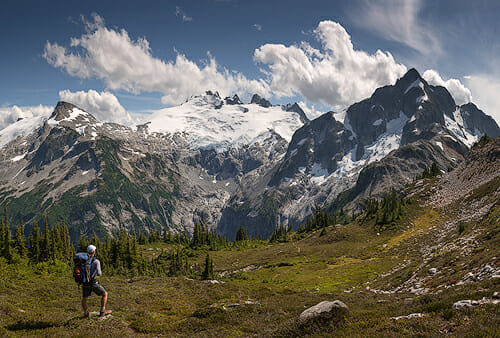 This backpacking checklist covers exactly what you need to take hiking, without carrying extra weight, or wasting money on useless gear.
This backpacking checklist covers exactly what you need to take hiking, without carrying extra weight, or wasting money on useless gear.
I’ve tested all equipment for 200 nights on the trail, over a 20,000-mile hiking career, to ensure the best backpacking gear for every scenario.
Scroll down & get the backpacking checklist.
Table of Contents
- Backpacking Checklist & Tips Videos
- Big Hiking Mistakes to Avoid
- Best Tents for Backpacking
- Sleep System – Sleeping Bag / Quilt, Pad & Pillow
- Best Backpacking Backpack
- Stuff Sacks & Equipment Organization
- Clothes & Layering Systems
- Small Essential Equipment
- First Aid Kit for Hiking
- Toilet Kit & How to Use It
- Food & Supplements
- Bear Containers & Food Storage
- Cooking System & Stoves
- Water Purification & Storage
- Snow Travel & Cold Weather Camping
- Maps & Navigation
- Bonus Section – 3 Essential Backpacking Tips
- How to 10X Your Learning Speed
Backpacking Checklist & Tips Videos
Watch the videos first then read the guide below.
Big Hiking Mistakes to Avoid
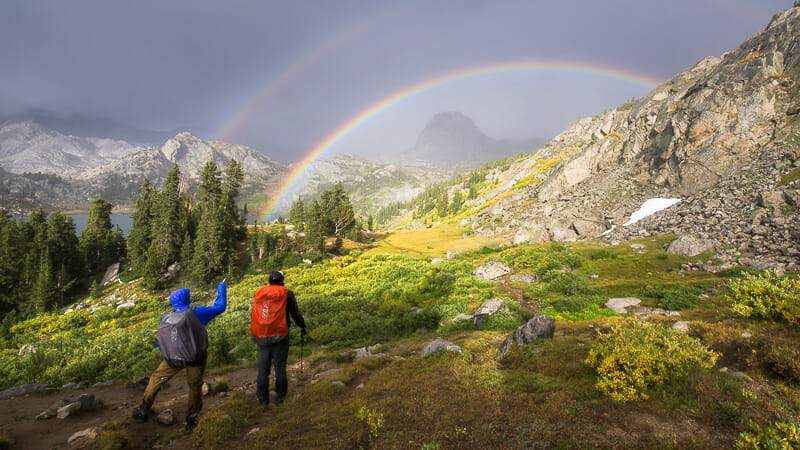
Most backpackers make 3 big mistakes & spend their trips tired or miserable.
These mistakes are:
- Heavy backpack from too much useless gear
- Decision fatigue from too much useless gear
- Too tired to enjoy hiking, from items noted above
I made all of these mistakes, but 20,000+ miles on the trail provided some better alternatives.
Let’s start with all the stuff you don’t need.
This will ensure you don’t waste money and carry extra weight.
The backpacking checklist is below that.
Backpacking Gear You Don’t Need
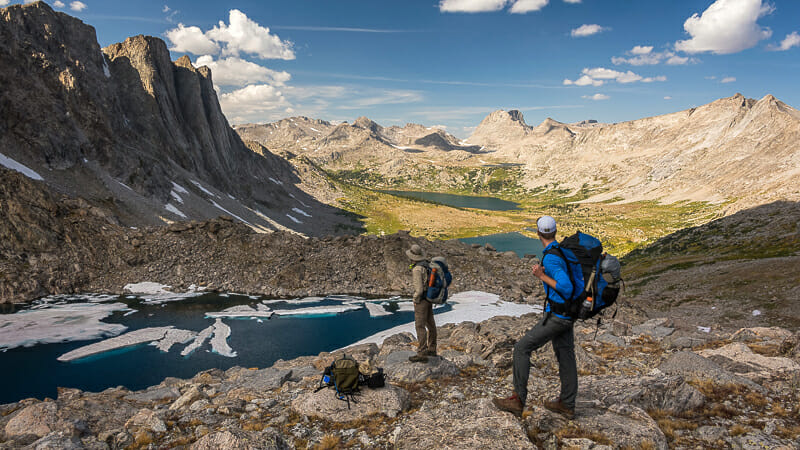
Soap: Wash your body with water. Soap is bad for the rivers. Hand sanitizer for hands after the bathroom.
Extra Clothes: Backpackers need two sets of clothes, no duplicates.
- Trail clothes
- Camp clothes
Deodorant: Wash daily & do without it.
Carabiners: Only for technical mountain climbing.
Camp Towels: Heavy! This light 13″ X 17 ” swimming towel and your body heat is all you need.
Boots: Wear trail runners instead. They are light, dry quickly, and keep your feet from getting sore.
Bug Repellant: Under high bug pressure nothing works, instead:
- Camp in windy locations.
- Stay on the trail until it cools down.
- Use a Bug head net.
Music Speaker: Wear headphones.
Water Bottles: Heavy & bulky! Use water bags.
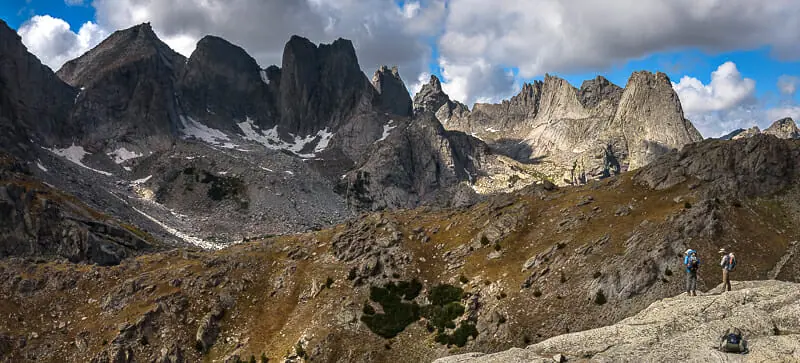
Camp Chairs: Sit cross-legged on the ground with foam pad
Cooking Pots, Pans & Plates: Heavy! Cook, eat, and drink with a titanium pot and small burner.
Carrying Too Much Water: Water is essential to carry, but it’s also very heavy.
If you’re hiking by streams, lakes, and water all day, carrying 2 liters on your back is crazy. That’s 4 pounds!
Don’t skip on water. Instead, make calculated decisions on when & where to fill up.
Too Much Gear On Outside of Backpack: Only daily “trail use” equipment should be stored outside of the backpack. Anything stored on the outside can:
- Get lost or snagged
- Get wet/heavy
- Throw off-center of gravity making hiking harder
It also looks sloppy, but I’m OCD about this stuff:)
Let’s get into the backpacking gear checklist…
Best Tents for Backpacking
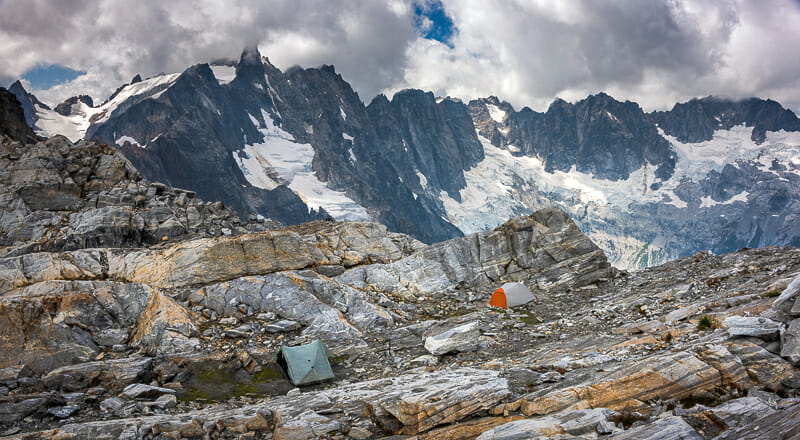
Zpacks Duplex Tent: I use and recommend the Zpacks Duplex Tent for backpacking & landscape photography.
- Weighs 1 pound
- Waterproof (Dyneema Material)
- Holds up in 60 mph winds (tested by me)
- Can fully sit up at 6’2″ tall / spacious to wait out long storms
- I’ve used it for 300 nights on the trail & it’s my favorite tent of all time
MSR Regular Size Tent Stakes: I carry 8 for the tent above. Don’t get the small version of these.
Cheaper Backpacking Tent Options
When starting out I used cheaper tents that are not waterproof and weigh much more.
If you have the money, go with the Zpacks tent above.
If you are on a budget, these tents are average but are not optimal.
Sleep System – Sleeping Bag / Quilt, Pad & Pillow
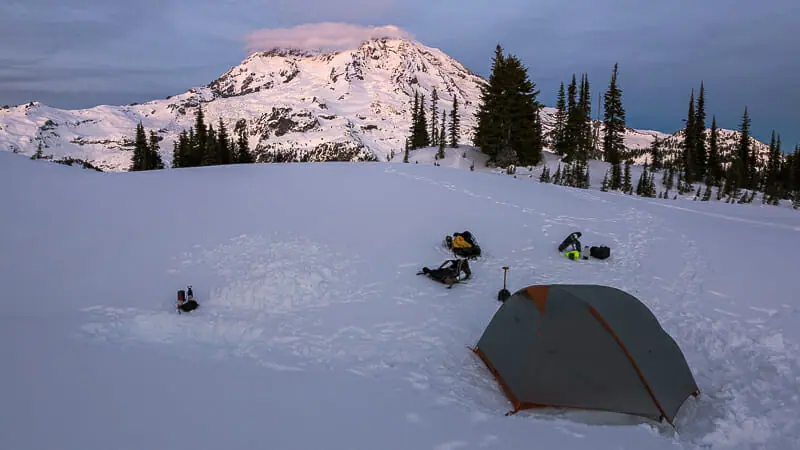
Down sleeping quilts are lighter and more versatile than sleeping bags.
Inflatable sleeping pads are the best option for the highest warmth to weight ratio.
10 Degree Sleeping Quilt (950 Fill): Minimum temperature range 40 degrees to 0 degrees F. I layer down pants and coats at night for lower temp ranges. When its between 30-40 degrees I use the quilt at camp instead of bringing extra layers. This saves weight.
30 Degree Quilt (950 Fill): Minimum temperature range above 40 degrees.
Pillow: Great way to improve sleep for 3 extra ounces of weight
3 Season Sleeping Pad: All conditions & seasons less snow camping. (Regular / wide size)
Winter Sleeping Pad: Snow camping or very cold weather.
Ear Plugs: On stormy or windy nights it can be very hard to sleep. These are essential to always have in your kit.
Best Backpacking Backpack
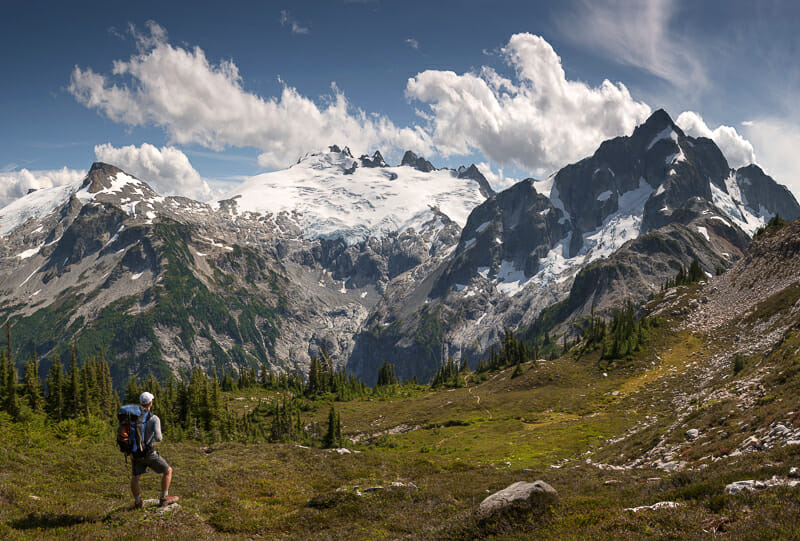
Simplicity is essential for backpacking backpacks.
Don’t buy complex packs, with a million weight-adding features & straps from REI, Deuter, or Osprey.
They are heavy, complicated, and don’t work well.
When selecting a backpacking & photography backpack, I look for:
- Simplicity (no extra straps or pockets)
- Low weight (2.5 lbs or less)
- Waterproof (Dyneema material)
- Durability (Dyneema material)
- Storage compacity (modular & works for all trips)
I Recommend Hyperlite Mountain Gear Backpacks
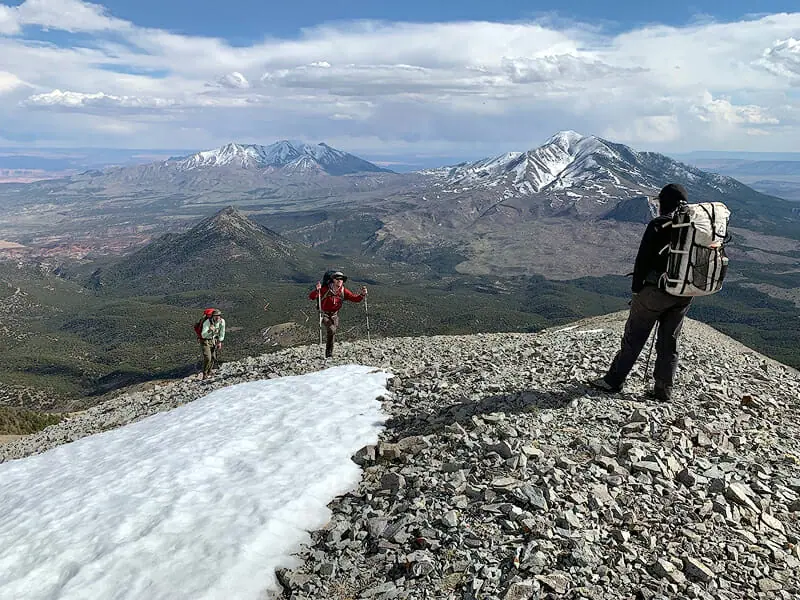
I’ve put these packs through the wringer over the past 5 years. Nothing else even comes close.
They are light, tough, waterproof, and very efficient for packing.
Hyperlite Mountain Gear – Northrim 70L: My go-to pack for all trips less than 10 days.
Hyperlite Mountain Gear – Porter 85L: My go-to pack for pack rafting and 10+ day trips.
Porter Back Pocket for Pack: Great for storing water, snacks & quick access gear.
Stuff Sacks & Equipment Organization
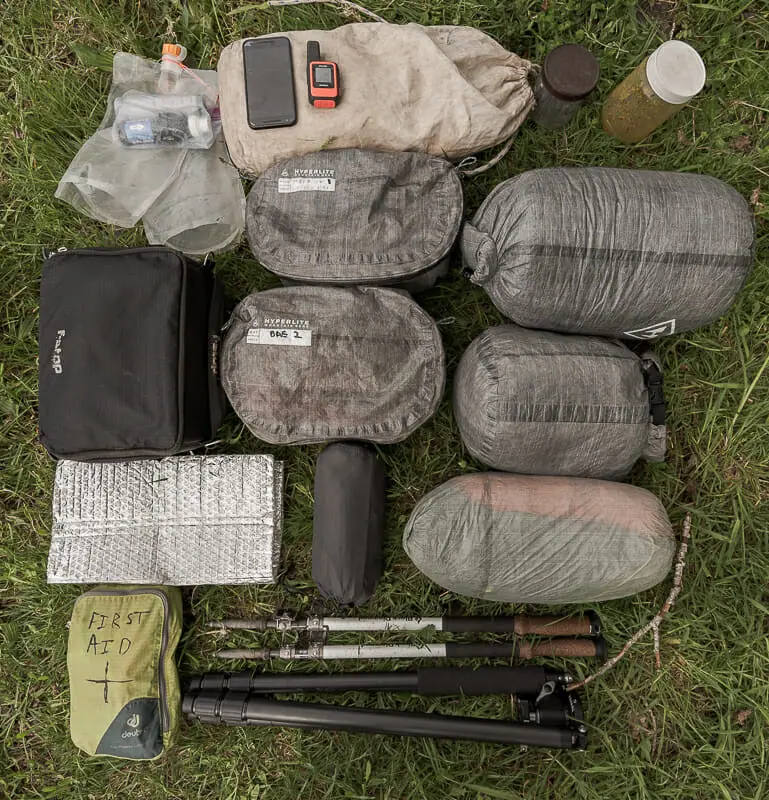
Stuff sacks are used to organize gear & keep it dry in your backpack.
Everything should have an exact location in your pack.
Hyperlite XL Stuff Sacks: I carry 3 of these. 2 for storing clothes and 1 to protect my camera gear from rain.
They are lightweight, waterproof, and durable.
Hyperlite POD (4400, 70L) Large Size: I carry 2 of these. 1 for storing small essential equipment. 1 for daily food supplies.
Scent Free Trash Compactor Bags: For wet conditions, line the inside of your pack with a trash compactor bag, then place all stuff sacks and gear inside of this. Depending on trip length, you may need 2.
Ursack Major Animal Proof Food Storage Bag: Only used on trips where I cache food.
Small F-Stop ICU for Camera Equipment: See my camera equipment page for complete details.
Clothes & Layering Systems
Correct layering is essential for keeping you warm & dry in all conditions.
Incorrect layering leads to increased pack weight or dangerous scenarios where you can’t stay warm and dry.
No one piece of gear should perform the same function as another piece of gear.
- When it’s cold layers are added.
- When it’s warm layers are removed.
- If it’s wet or snowing the shell coat and pants are added over whatever you’re wearing.
Layering Basics
Base Layer (Keeps Skin Dry & Ventilated): This is the layer directly next to your skin.
- The goal of the base layer is to keep your skin dry by removing moisture.
- It will keep you cool in warm temperatures and warm in cool temperatures.
- You’ll wear a base layer year-round, no matter what season.
Middle Layer (Warmth & Insulation): During cool summer nights, autumn, or winter you’ll also need a middle layer.
- The goal of the middle layer is to keep you warm but also allows the skin/body to breathe.
- Good middle layers are breathable material that also provides warmth such as fleece or down.
- I prefer to carry a down jacket as well as a fleece as denoted below.
Top Layer / Shell (Weather Protection): The goal of the top shell layer is to protect you and all of your layers below from the weather.
- The top layer is just as important as your other layers if not more so.
- If your middle or base layers are completely wet they won’t work very well.
Go Gear – What to Wear on the Trail

Below is my base layer of “go gear”.
It is worn on the trail, every day of the trip, during every season.
Go Gear will get sweaty, wet, and dirty.
You get used to this very quickly.
Bringing duplicate pieces of “go gear” is too heavy and unnecessary. Skip it!
Trail Hat: Light weight trucker hat.
GPS Watch: Essential for knowing distance covered, elevation covered, and current weather trends such as pressure, temperature, sunrise & sunset times. My favorite feature of this watch is the topo maps. Instead of pulling out a phone to navigate, looking at the watch is much easier and saves a ton of time.
Long Sleeve Trail Shirt: Merino wool, light weight, cool in hot weather, and warm in cool weather. Hood is essential for sun and cold.
Running Shorts: Stretchy durable material that takes a beating is essential for backpacking & climbing.
Socks: Darn Tuff socks have a lifetime warranty. If you get a hole, just send them back in for a new pair.
Compression Socks: Great for long days on the trail.
Trail Runners (Altra Lone Peaks): Stop wearing boots. They are heavy, don’t provide better ankle support, and become very heavy when wet.
Trail runners are light, dry quickly, give your feet a better “feel” for the trail, and work well in all seasons. I even wear them in the winter.
Trekking Poles: Essential for reducing stress on legs and covering long days on the trail. Also essential for off-trail travel & holding up the Zpacks Duplex Tent.
Thermal Sitting Pad: Weights 3 oz. Reduces your calorie burn by decreasing heat loss while sitting. Very comfortable. Taken in every season.
Camp Clothes & Cold Weather Layering
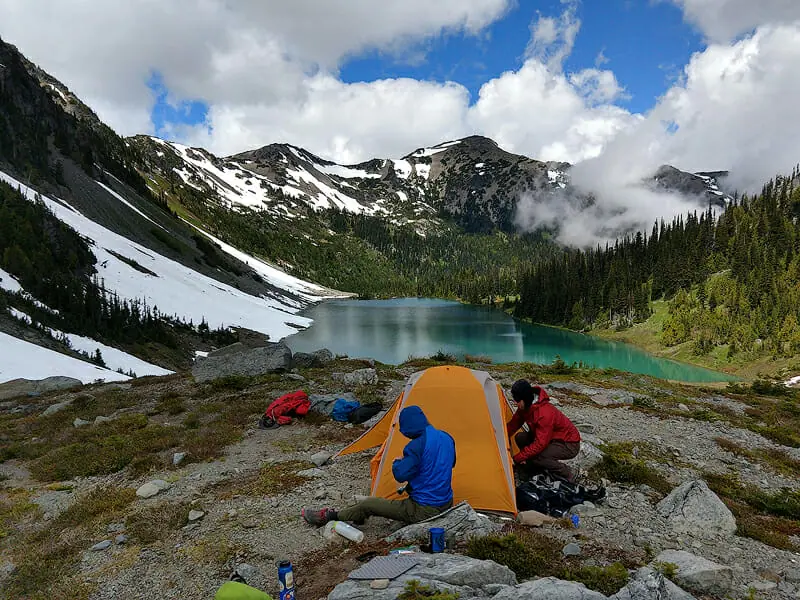
Layers are listed from the skin or base layer first to the outer layer last.
- If you are going to use a layer on the trail, it has the chance of getting wet.
- Make sure you don’t need that wet layer for staying warm at night.
Top Layers
Base Layer Shirt: Merino wool insulates even when wet. Also very soft. 320 weight for cold weather and 250 weight for spring / summer.
Fleece Hoody: 7 ounces. Very warm and versatile.
Light Down Jacket: Worn at camp or on-trail rest breaks during late spring, summer or early autumn, in all ecosystems.
Medium Down Jacket: Worn at camp or on-trail rest breaks during early spring, late autumn, and winter.
Down Vest: I have not tested this vest for 200 nights on the trail yet. So far, I love it. Currently experimenting with the warmth benefit of a vest instead of a light down jacket for layering with medium down jacket. So far, on the 3 trips I’ve done with this vest, I’m going to use it instead of the light down jacket.
Heavy Down Jacket: Layer the medium down jacket with the light down jacket or down vest. My preference is medium down jacket + vest.
Rain / Wind Shell Jacket: I don’t recommend Goretex jackets unless it’s very cold weather where wind protection is essential. Goretex is heavy and takes too long to dry once wet.
Bottom Layers
Long Underwear: Merino wool insulates even when wet. Also very soft. 320 weight for cold weather and 250 weight for spring / summer.
Down Pants: Worn at camp during trips with lows in the 30s. Lighter than another pair of long underwear.
I don’t recommend heavy-down pants. They are too warm unless you’re in arctic winter environments.
Wind / Rain Shell Pants: Worn at camp or on the trail during windy, cold, or wet conditions.
Gloves & Hats
Light Gloves without Fingers: Worn on any trips above 30. Great for photography.
Light Gloves with Fingers: Any trips between 30 to 20F.
Winter gloves: Below 20F. Order a size up on these and layer them with wool gloves above.
Merino Wool Hat: All trips, no matter the season.
Camp Socks
Thin Socks: Worn at camp during spring and summer.
Thick Socks: Worn solo in cold weather. Layer over thin socks for very cold.
Camp Shoes & Sandals
Bread Bag Technique: Don’t bring camp shoes or sandals. They are too heavy!
- When you get to camp, dry your feet and put on your dry camp socks.
- Over your camp socks, put on two bread bags.
- Put trail shoes back on over bread bags.
Your feet and socks will stay warm and dry inside the bread bags.
Your body heat will dry your trail shoes.
Down Booties: For snow or very cold weather trips down booties are essential to keep your feet warm.
Cold weather and snow also means longer nights and more time spent hanging out around camp after dark.
Being able to sit outside in the snow, with warm body and feet makes the trip way more enjoyable.
Small Essential Equipment
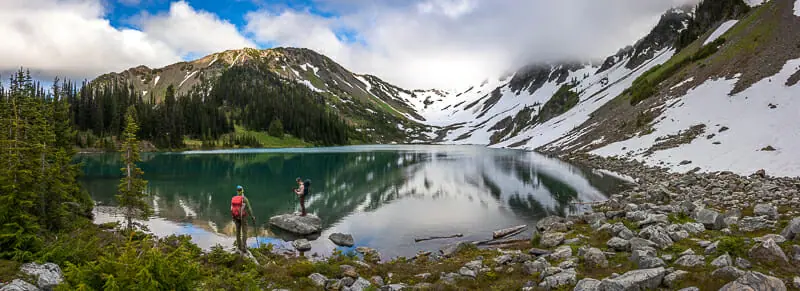
This section covers task-specific small items that are required for every backpacking trip.
Keep them in a small storage stuff-sack, close to the top of your bag for easy access.
Hyperlite POD (4400, 70L) Large Size: Holds all small essential equipment.
Small External Battery Charger: 3 days of charge for Nikon Z7, Go Pro, and phone.
Large External Battery Charger: 7 days of charge for Nikon Z7, Go Pro, and phone.
Headlamp with Batteries: 350 lumens or more is recommended. 1 set of batteries for every 4-5 days, depending on day length.
Small Camp Towel: Use this to wash, then wring it out to dry 90% of the moisture off your body. Put warm dry clothes off and let your body heat dry the rest.
60 Feet of Utility Cord: Dyneema cord is light. Use it to hang food, create make-shift splits for first aid, repair gear & more.
Mini Bic Lighter: Light camp stoves & make fires.
Mosquito Net: Only taken during high bug pressure times.
Chapstick
Sun Protection Lotion: Use a small Nalgene bottle and fill it with lotion to reduce weight.
Sun Glasses: Essential for snow trips. Recommended for all trips.
Tyvek Tape: Essential to repair & patch tents, sleeping pads, packrafts, or any other piece of equipment. Strong & light. Backroll a small amount, just enough for trip.
First Aid Kit for Hiking
Here’s my complete guide on What Should Be in a Hiking First Aid Kit.
Toilet Kit & How to Use It
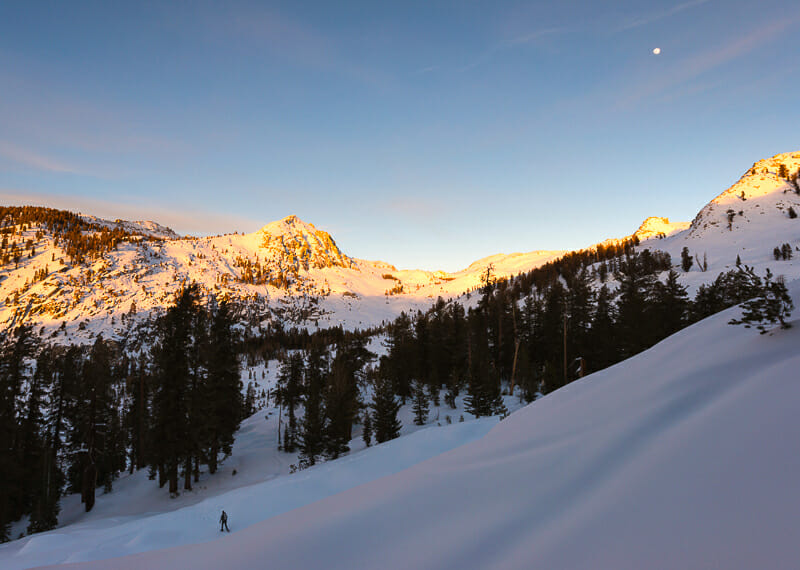
Bathroom Technique
Pee anywhere off the trail preferably on rocks or gravel.
Poop using the following technique.
Carry out all dirty toilet paper with you.
- Locate an area with soft organic matter at least 200 feet away from any water sources.
- Organic matter will decompose human waste, rocks and sand will not.
- Dig a hole 6-8″ deep, with 6-8″ diameter.
- Upon completion, backfill the hole and firmly stamp it down.
Equipment List
Gallon Ziplock Freezer Bag to hold the following.
Duece Bathroom Shovel: Weighs less than an ounce. Strong. Works well!
Toilet Paper – Thin Ply: Backroll it and only take enough for the trip. Keep in a small ziplock bag.
Hand Sanitizer – Travel Size: Small travel size. Keeps you from getting sick on the trail from dirty hands.
(2) Quart Ziploc bags for dirty toilet paper. Put the dirty toilet paper in one bag, then double bag it to keep things clean.
Poop Bags: All snow trip. Don’t poop in the snow. It will melt out in the spring and is disgusting.
Food & Supplements
I make my own pre-made meals for backpacking trips.
It’s much more nutrient-dense and tastes better than the store-bought stuff.
If you’re just getting into backpacking, use Mountain House Premade Meals at first.
It will reduce the stress of learning everything else about backpacking.
Once you are an expert at all the equipment, then start making your own meals.
Here’s how I do it:
Food Dehydrator
I prepare rice & quinoa in a dehydrator as the base for all meals.
Both are high in carbs & protein, essential for long trips.
Excalibur 9-Tray Electric Food Dehydrator
Sheets for Dehydrator (You Need 9 Total)
Breakfast Ingredients
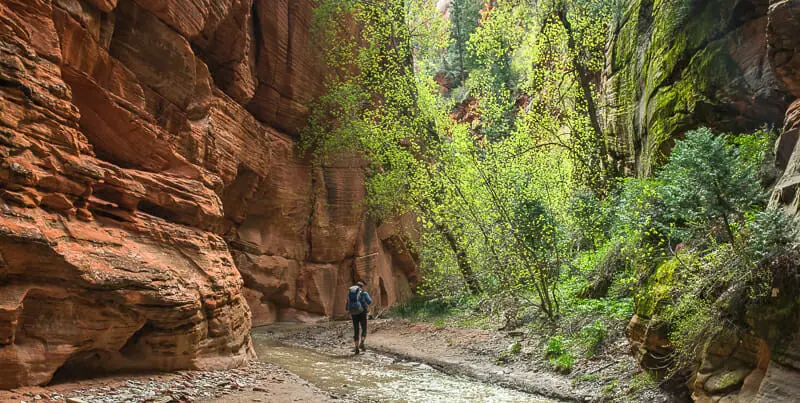
Organic Instant Coffee: This stuff tastes so good that I use it at home.
Before the trip add all the following ingredients to a big plastic container with lid, and shake it up.
Next, add one cup of mix to a Zip-lock style snack bag per meal.
Each meal is premade before the trip, making trail consumption quick & easy.
To eat on the trail, add water and the following & mix up:
Bulk Peanut Butter: I carry 16 oz of peanut butter for every 2 days of a trip. This is the most calorie-dense food you can buy, providing a high calorie to weight ratio.
Lunch & Dinner Ingredients
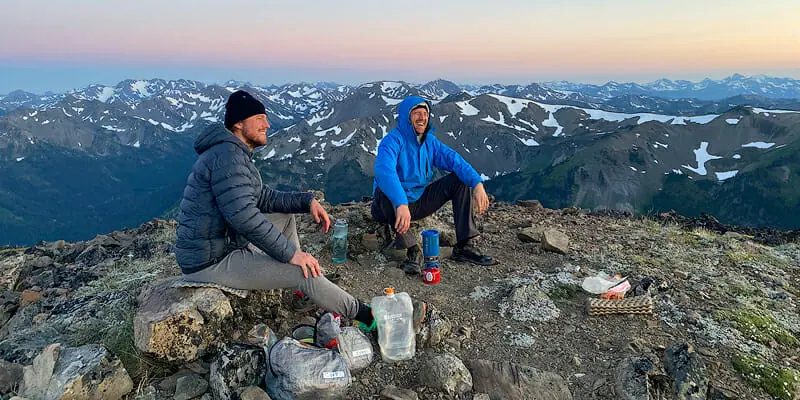
Buy these bulk & dehydrate them on your own.
Dehydrated Basmati Rice: I cook & dehydrate this.
Dehydrated Green Lentils:I cook & dehydrate this.
Dehydrated Quinoa: I cook & dehydrate this.
Dehydrated Mushrooms: Buy fresh, slice & dehydrate
Frontier Deluxe Vegetables Soup Blend
Frontier Co-op Beans, Black Flakes
Before trip, add all ingredients to a big plastic container with a lid and shake it up.
Change up portions of each ingredient to your liking.
Next, add one cup of mix to a Zip-lock style snack bag for every meal.
I eat one bag of the mix for lunch & one for dinner.
Spices & Flavoring for Meals
I eat the same meals every day and flavor them differently.
This makes trip planning and prep very easy.
Here is what I use to flavor meals & add taste.
Trail Snacks
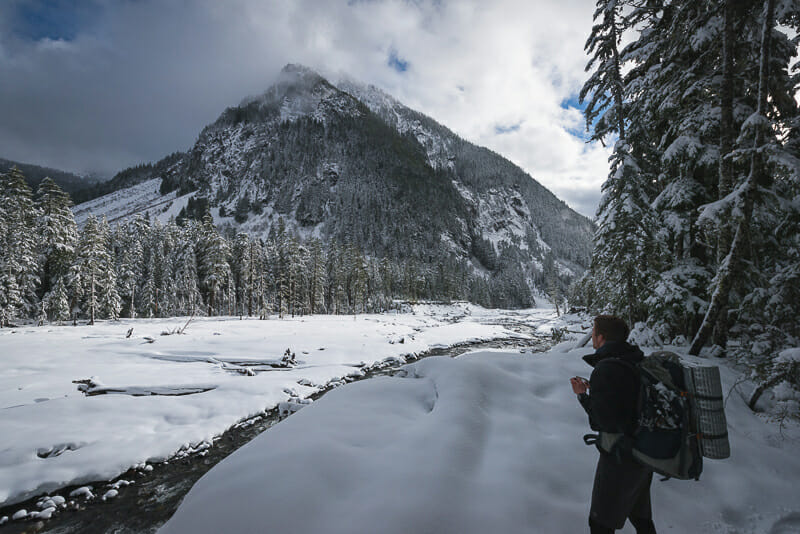
Whole Wheat Tortilla with peanut butter, coconut milk powder, and olive oil.
Cliff bar / high calorie per oz energy bar: Cliff Bars are the highest calorie/ounce bar that tastes good. This means the most calories for the least amount of weight.
Raw Greens Superfood Powder + big spoonful of Coconut Milk Powder. Shake up in Talenti Ice Cream cup or Jetboil.
Theo Dark Chocolate with peanut butter on it.
Backpacking Supplements & Greens Powder
Supplements are essential to maintaining energy while on the trail, especially on trips longer than 2-3 days.
This is my regimen.
Greens Powder: 1-2 scoops in water a day. Drink with food or coconut milk powder for optimal uptake.
Multivitamin: 2 with the first meal & 2 with the second meal
Caffeine Pills: Early starts with no time for coffee. Emergency scenario with all-night evac. As required any other time.
B-12: 2 in the am.
Electrolyte Pills: 1 in am, 2-3 during day as required, 1 before bed
Bear Containers & Food Storage

Do what makes you feel comfortable.
Just because I use one method does not mean it will be right for you.
My food is always kept in a Loksak odor-free storage bag inside a stuff sack.
If I need to cache food or leave it alone for a day, then a Ursack Major Bear Bag is used for protection along with hanging it from a tree if available.
I don’t use bear containers & sleep with my food by my head, unless in grizzly country.
Bear cans are heavy, bulky, and horrible for enjoyable backpacking trips.
- They are only necessary when in grizzly country.
- Some parks without grizzly bears require them because government & nuance don’t mix.
The bear can I used in the past is now a stool for sitting by the campfire.
It worked well…if you want to carry around a bear can.
Cooking System & Stoves

During spring, summer & early fall, I don’t carry a stove and use the cold soaking food preparation technique covered here.
During the winter or for shorter trips where I don’t mind carrying extra weight, I make the meals noted above, with a Jetboil stove.
Stoves can also be used to melt snow for water on all snow trips in the winter.
Cooking Equipment
Titanium Pot: Very light. Small fuel & burner stove fits inside it. Use with burner below.
Cooking Stove / Burner: Very very light. Use your body to protect it from the wind when cooking. The only time I don’t use this is on trips where I have to melt snow for water. For snow trips, I use a Jetboil.
Cleaning Rag: Used to clean pot & spoon after eating. Wrap your small fuel inside this rag and place it in the titanium pot. Then put the burner on top of that. It all fits.
Mini BIC Lighter: Your stove starter will eventually fail if you’re backpacking enough;)
4 Oz. MSR Fuel: 2 days in winter when melting snow / 3-5 days in other seasons.
8 Oz MSR Fuel: 4 days in winter when melting snow / 6-10 days in other seasons.
Water Purification & Storage
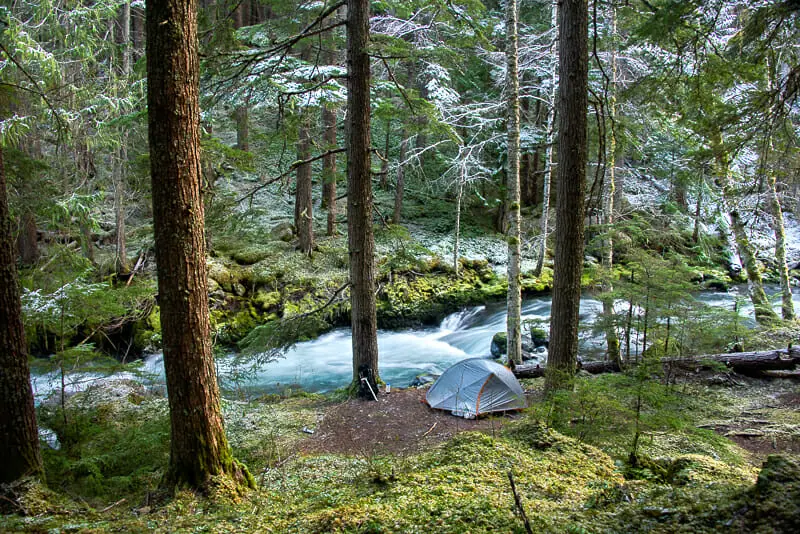
Only Carry Water You Need – Cut Down on Weight & Save Energy
At each water fill-up stop:
- Check your map and locate your next water source
- Fully hydrate at each water stop. “Camel Up” so your stomach is full.
- Determine how many miles/hours until your next water source before leaving.
- Only carry what you need to get there plus a 1/4 liter extra.
Water Carrying Bags: I take 2 bags, equaling 4 liters total, for mountains and all non-desert environments.
For deserts, I carry 4 of these, for 8-liter carry capacity.
I don’t recommend Nalgene bottles or bladders with drinking tubes. They are heavy and often fail.
Keep it simple!
Water Purification
I use bleach for this. It’s the easiest method and very fast.
One of these medium droppers will provide 10 days of clean drinking water.
Here are the directions.
Only the filter is required. Don’t buy any other gadgets that are offered with it.
The filter is heavier but you get instant access to water.
Filters do not protect you from every type of contamination as bleach does.
I prefer drops.
Snow Travel & Cold Weather Camping
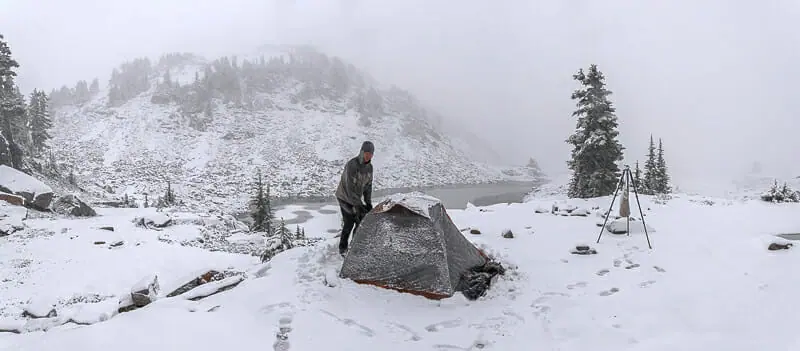
If you’re just starting out, skip the snow and winter camping.
It’s too much gear and extra skill when just starting.
Ice Axe: Any steep ice or snow travel without safe runout. Does not work if you don’t know how to use it!
Micro Spikes: Non-glacier ice travel
Winter Boots: only wear with snowshoes. Otherwise, wear trail runners.
Snowshoes: 6″+ deep snow or more.
Gaiters: Keeps snow out of your boots.
Poop Bags: All snow trip. Don’t poop in the snow. It will melt out in the spring and is disgusting.
Wax Fire Starters: Emergency use & standard fires. It’s sometimes impossible to find dry wood in the winter.
Rescue Shovel: Great for moving snow to set up camp and avalanche rescue.
Avalanche Beacon: Only works if you learn to use it very well & practice.
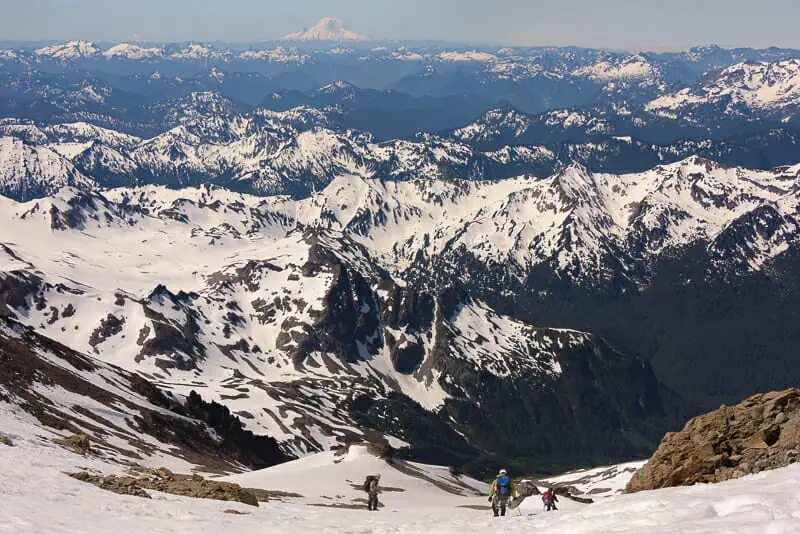
Navigation & first aid are the two most important backpacking skills.
Always carry a hard copy map as a backup, a digital map on your phone, and a compass.
All of this equipment is worthless if you’re not an expert at using it.
Take a class or go out & teach yourself in a safe area with phone service.
Here is what I use:
Digital Maps: I use and recommend GAIA GPS. It’s great for planning on the computer and navigating in the field using a smartphone.
Map Physical: Print maps or buy National Geographic Trails Illustrated Maps.
Bonus Section – 3 Essential Backpacking Tips
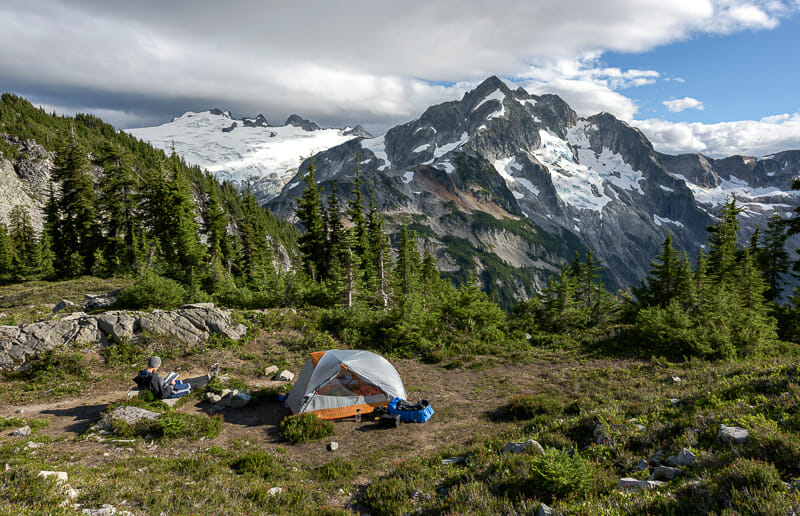
Tip 1: Buy the Best Backpacking Gear You Can Afford
Higher quality backpacking gear, although more expensive, performs exponentially better, and lasts much longer.
In the long run, it’s much cheaper to invest in the beginning, and enjoy your equipment for years.
Tip 2: Don’t Buy All Your Backpacking Gear at Once
Start out with a few basics on a 1-night trip during nice weather.
Take note of items you use and don’t use on this trip.
Buy or reduce gear upon returning home.
Repeat this cycle while slowly increasing the trip length & difficulty.
Tip 3: Don’t Trust Gear Review Videos IF The Gear Isn’t Worn Out
All equipment provided on this page has been tested for a minimum of 200 nights on the trail.
Lots of “gear reviewers” don’t backpack and hike for a living.
They review gear for a living. This is their entire income.
This incentivizes them to quickly test gear then recommend it to you to make money.
Sometimes the recommendations work out.
Sometimes they are horrible.
If the gear isn’t filthy and worn out, most likely it hasn’t been tested very well.
How to 10X Your Learning Speed
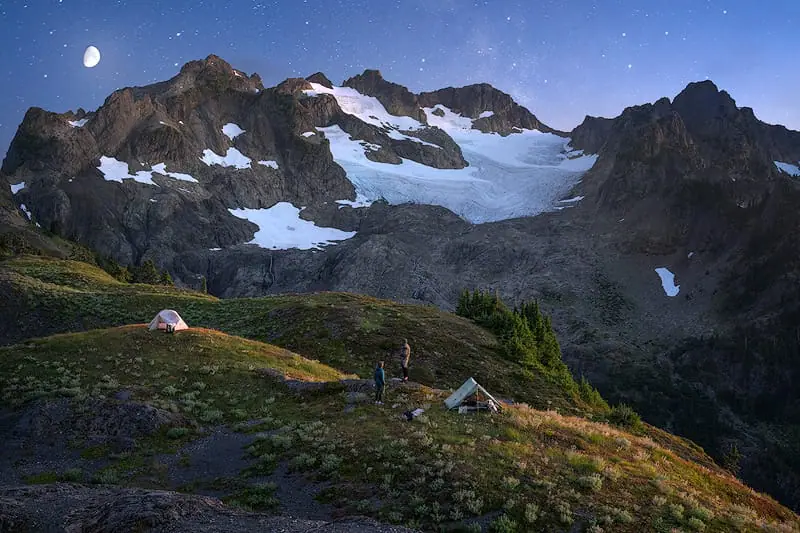
The best way to improve quickly is by learning firsthand from someone that’s optimized their skills, over a decade or more through trial and error.
You can’t read blogs and watch internet videos to do this.
I offer workshops & tours for all skill, fitness, and age levels.
Over a 3-day weekend, I can teach you everything I know, plus provide 1 on 1 feedback that will quickly improve your skills.
I’ve seen students learn more in a 3-day trip than they have in 20 years of trying to learn on their own.
Check out my workshops & tours, right here.